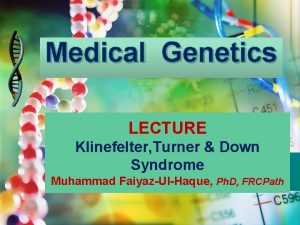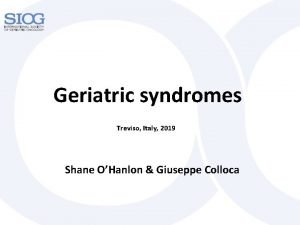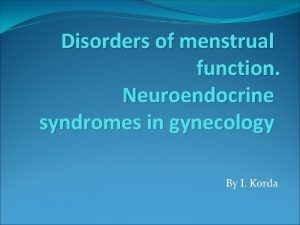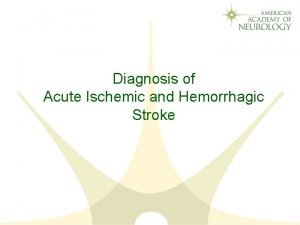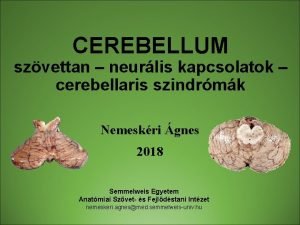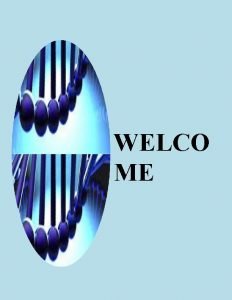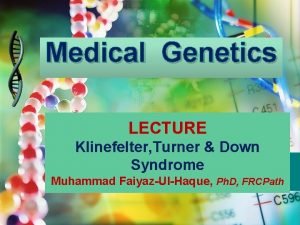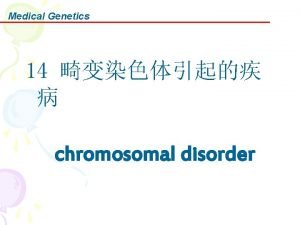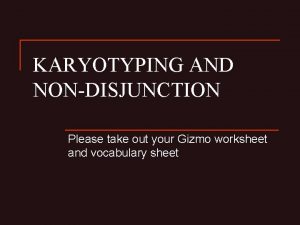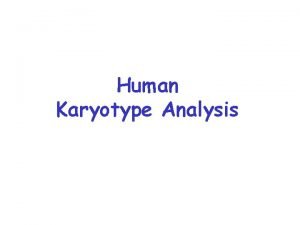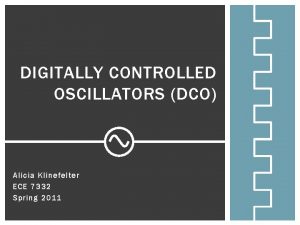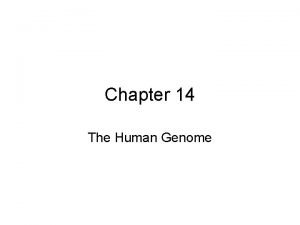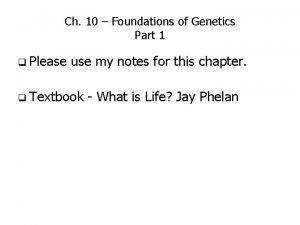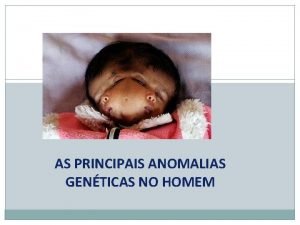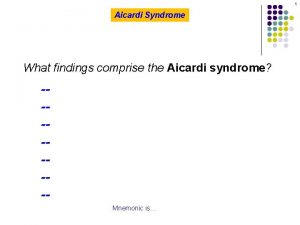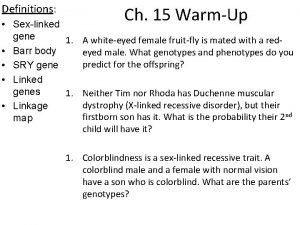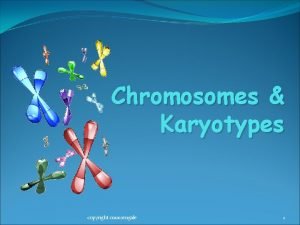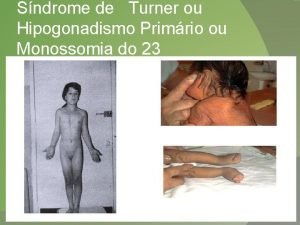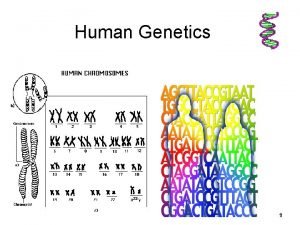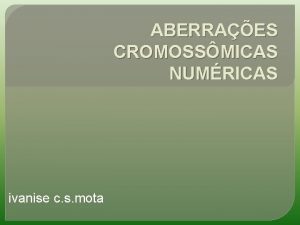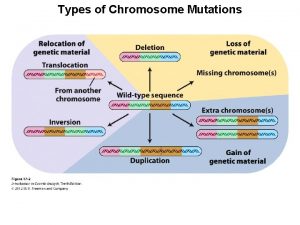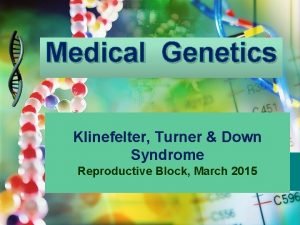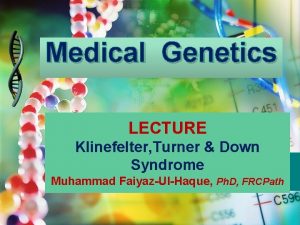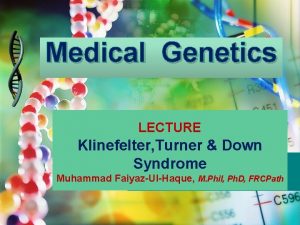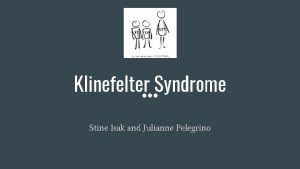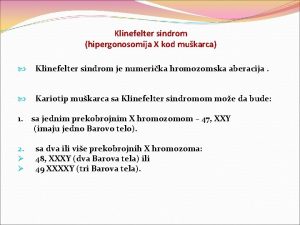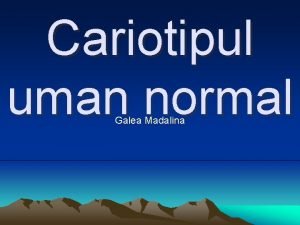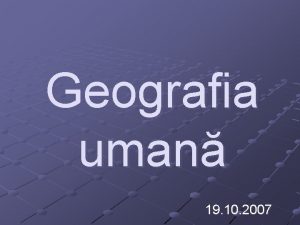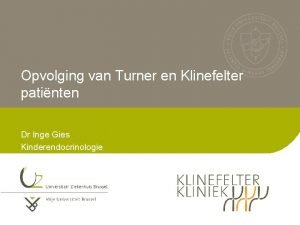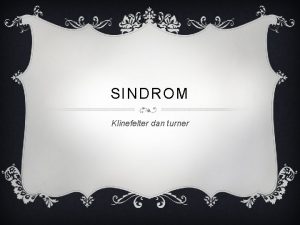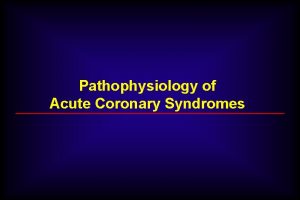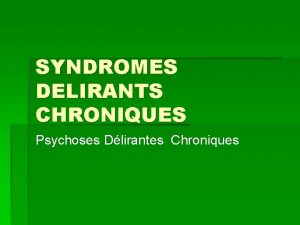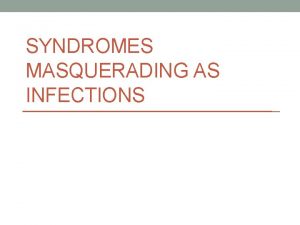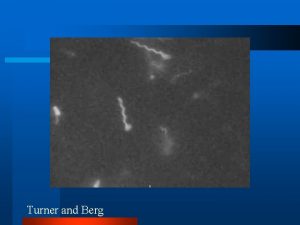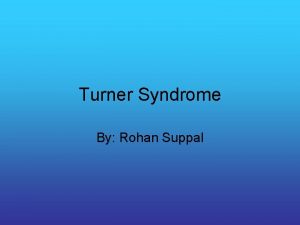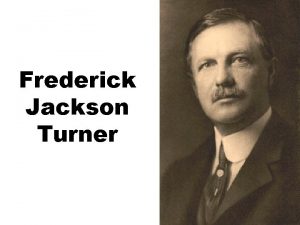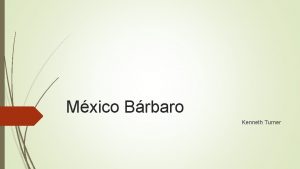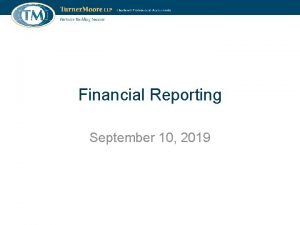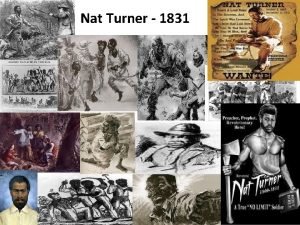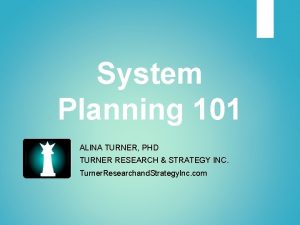H uman Genetics Klinefelter Turner and Down Syndromes




























- Slides: 28

H uman Genetics Klinefelter, Turner and Down Syndromes ü Notes ü Important ü Extra EDITING FILE

I. Describe cell cycle and stages of Mitosis and Objectives Meiosis. II. Define nondisjunction and describe its consequences for meiosis and mitosis. III. Classify chromosomal abnormalities. IV. Understand the common numerical chromosomal disorders: monosomy and trisomy. V. Understand the common numerical sex chromosome disorders: Down , Turner & Klinefelter syndromes.

What is Chromosome? A thread-like structure of nucleic acids and protein found in the nucleus RECALL (Extra) of most living cells, carrying genetic information in the form of genes. Human Chromosome: In humans cells, there is a set of 46 chromosomes organized in pairs 23 pairs per cell- and it is divided into two types: • 22 pairs of autosomes • One pair of sex chromosomes (Either XX or XY) Role of Chromosome: • Carry genetic material • Heredity • The intact set is passed to each daughter cell at every mitosis

• Dr. Maram went through this quickly but she said (focus on the finale result of cell division). The Cell Cycle: Cell Division • Cellular components are replicated = Interphase • Cell distributes its contents into two daughter cells = Mitosis • G 1 and G 2 = cell duplicates specific molecules and structures • S phase = cell replicates DNA EXPLANATION : o The first step in the Cell Cycle is the INTERPHASE, which is divided into : G 1 , S , G 2. o Interphase : the cell is growing and preparing to divide (it copies the DNA in preparation for mitosis), it spends most of its life in this phase. o G 1: the chromosomes will UNTWISTED. o S: the genetic material will be replicated. o G 2 : after replication they will be condensed again. o Following the interphase, the cell enter into MITOSIS which has FOUR phases : Prophase, Metaphase, Anaphase , Telophase. o The last step is the CYTOKINESIS : which is the division of the cytoplasm. The Cell Cycle (video)

Cell division is ( EXTRA but READ IT for better understanding) : The series of events that take place in a cell leading to its division and Cell Division (Extra) duplication of its DNA (DNA replication) to produce two daughter cells. § There are two distinct types of cell division which are: ① Mitosis ❷ Meiosis Mitosis VS Meiosis: • Mitosis is a vegetative division, whereby each daughter cell is genetically identical to the parent cell. • Meiosis is a reproductive cell division, whereby the number of chromosomes in the daughter cells is reduced by half to produce haploid gametes.

Cell Division Mitosis in a human cell (Watch the Video for better understanding) Dr Maram said events during the cells division are not important except METAPHASE • It is IMPORTANT to know that NON DISJUNCTION (Not getting separated) happens at the ANAPHASE (the stage of separation), Either in Mitosis or Meiosis. • Chromosomes align during metaphase to be prepared for anaphase. Mitosis (Video)

Meiosis in human cell (Watch the Video for better understanding) Meiosis II Cell Division Meiosis I • It is IMPORTANT to know that NON DISJUNCTION at the ANAPHASE 1 is more susceptible to have the abnormality. Meiosis (Video)

Comparison of Mitosis and Meiosis This table is IMORTANT (Focus on the Red) Mitosis Meiosis One Division Two Divisions Two daughter cells per cycle Four daughter cells per cycle (Haploid) Daughter cells genetically identical Daughter cells genetically Different Chromosome number of daughter cells same as that of parent cells (2 n) Chromosome number of daughter cells half that of parent cells (1 n) Occurs in somatic cells Occurs in germline cells (ovum and sperm) Occurs throughout life cycle In humans, completes after sexual maturity Used for growth, repair, and asexual reproduction Used for sexual reproduction, producing new gene combinations

Comparison of Mitosis and Meiosis Summary of the chromosome and chromatid number during Mitosis, Meiosis I & II in humans: “you Don’t have to worry about it just focus on the end product” (Haploid )

Non-disjunction Nondisjunction (Not coming apart): It is the failure of a chromosome pair to separate properly during meiosis I or of two chromatids of a chromosome to separate properly during meiosis II or mitosis. It can affect each pair of chromosomes and is not a rare event. As a result, one daughter cell has two chromosomes or two chromatids and the other has none. (The aim of cell division is to get an equal number of chromosomes in each cell)rare” event? o What do we mean by “not • Those errors happen in daily basis during our life but since we have DNA repair, those errors cause no harm. Aneuploidy: It is the resulting cell of an imbalance of chromosomes due to nondisjunction. (A cell with the correct number of chromosomes is called a euploid cell). • Old age means slow cell division so nondisjunction increases. Examples: Autosomal: Trisomy 21 (Down Syndrome) Sex Chromosome: 47 XXY (Klinefelter syndrome) 45 X (Turner syndrome)

Non Disjunction in Meiosis 1 Non-disjunction Non Disjunction in Meiosis 2 The Non Disjunction happened at which phase? Anaphase (in MEIOSIS which is the topic of this lecture mainly). Results (Please MEMORIZE them they are IMPORTANT): Non disjunction in meiosis 1 : 2 Diosomy (50%) , 2 nullisomy (50%) Non disjunction in meiosis 2 : 2 haploid , 1 nullisomy , 1 Diosomy To Understand: Diploid (Diosomy) Haploid (monosomy) Nullisomy

Non-disjunction Resulting Cells during normal segregation and Nondisjunction in Meiosis: • Normal : 4 Haploid gametes. • Nondisjunction in meiosis I : 2 gametes with diploid number of X chromosome and 2 gametes lacking X chromosome. • Nondisjunction in meiosis II : 2 gametes with haploid number of X chromosome, 1 gamete with diploid number of X chromosome, and 1 gamete lacking X chromosome. o When I ask you why does the defect occur ? • Because of excess or loss of expression of the genes. o How ? • When you have an extra chromosome it will lead to extra expression of the gene so you will have an extra feature and vice versa for the loss of chromosome)

Chromosome Anomalies Down Syndrome: • Also known as trisomy 21, is a genetic disorder caused by the presence of all or part of a third copy of chromosome 21. (Extra) § Karyotype: • • • § Type of anomaly: • 47, XY, +21 (Trisomy 21) Numerical anomaly in autosome • Three copies of chromosome (Extra) 21 Most cases arise from nondisjunction restricted to meiotic errors in the egg. Mothers are the source of the extra chromosome in the majority of cases. Advanced maternal age was significantly associated with both meiosis I (MI) and meiosis II (MII). Nondisjunction occurred in MII, mothers were 15. 1 times more likely to be ≥ 40 years compared to 8. 5 times of nondisjunction in MI The father contributing the extra chromosome in 15% of cases (i. e. Down syndrome can also be the result of nondisjunction of the father's chromosome 21). A small proportion of cases are mosaic and these probably arise Down Syndrome (osmosis)

Chromosome Anomalies Down Syndrome • The incidence of trisomy 21 rises sharply with increasing maternal age. Meiosis II oocytes from younger and older women • As you can see the oocyte is disturbed with the increased age (basically the ovum also got aged), which increase the risk of the abnormality. Peak age for mothers with down syndrome babies

Chromosome Anomalies Dr Maram said read it with coffee Down Syndrome Features: Developmental delays (mental retardation) Head and facial malformations: (Small round face, protruding tongue = Sticks to the mouth floor) Low muscle tone = loose and floppy side Life expectancy increased from 25 in 1983 to 60 today Heart malformations Abnormalities of the extremities: (Short and broad hands, Stubby fingers), single deep crease across the center of the palm Impotency in males = Inability to sustain an erection sufficient for sexual intercourse or the inability to ejaculate

Sex chromosome imbalance is much less deleterious (Please memorize the karyotype of each disorder) 47, XYY Syndrome : Klinefelter Syndrome (47, XXY) • (May be without any symptoms). • Males are tall but normally proportioned. • 10 - 15 points reduction in IQ compared to sibs. Trisomy X (47, XXX) • females: It seems to do little harm. • Individuals are fertile and do not transmit the extra chromosome. • They do have a reduction in IQ comparable to that of Klinfelter males. Turner Syndrome (45, X and variants)

Dr Maram said read it with coffee Turner Syndrome (45, X and variants) : Turner syndrome (Now we moved to sex chromosome linked , Remember that Down Syndrome was Autosomal) • Monosomy of sex chromosome: (Monosomy X: 45, XO) i. e. only one X chromosome is present. • Note that it can be written 45, X or 45, XO ( the O is just to show that there is a missing chromosome). • Occurrence – 1 in 2500 live female births. • The only viable monosomy in humans. • Individuals are genetically female, not mature sexually and sterile. Turner Syndrome (Video)

Features of Turner Syndrome: Dr Maram said read it with coffee Turner syndrome Lack of ovarian development (Streak ovaries) = No ovaries Neck Short stature, abnormalities Increased risk of (webbed neck) osteoporosis, cardiovascular Broad chest, Low hairline (infertile) Normal life span anomalies e. g. Skeletal disorders (e. g. scoliosis, dislocated hips/elbows) constriction of aorta and hypertension No developmental delays, Normal intelligence

Features of Turner Syndrome Continued… Turner syndrome Cardiovascular : • Bicuspid aortic valve. • Coarctation of aorta. • Thoracic aortic aneurysm (aortic root dilatation). Skeletal : • • Short stature. Short 4 th metacarpal/metatarsal bone (± short 3 rd and 5 th). Osteoporosis (due to lack of estrogen). Scoliosis. Reproductive: • Women with Turner syndrome are almost universally infertile.

Klinefelter Syndrome • • 1 in 1, 100 births. 47 chromosomes. • Karyotype: 47, XXY. • Very rarely more extreme forms of Klinefelter syndrome occur where the patient has 48, XXXY or even 49, XXXXY karyotype. (These individuals are generally severely retarded). Klinefelter Syndrome (Osmosis)

Dr Maram said read it with coffee Klinefelter Syndrome Features of Klinefelter Syndrome: Sexually underdeveloped & infertile* (no spermatogenesis) Deficits in attention, auditory processing and social skills. Normal life span * In some cases testicular function is preserved Delays in speech and motor skills Tall Sparse facial and body hair Low mental ability (slight reduction in IQ, but usually normal intelligence)

Klinefelter Syndrome Dr Maram said read it with coffee Features of Klinefelter Syndrome Continued… Longer fingers and arms Delicate skin Gynecomastia and other feminine body characteristic Increased risk of autoimmune disorders, breast cancer, osteoporosis, leg ulcers, depression, and dental problems Treatment: • Includes testosterone therapy and assisted learning.

Tests When to do a chromosomal test: Test Measurement Indication Interpretation Pre-natal Ultrasound changes Maternal age >37 yrs , family history - Alpha fetoprotein (AFP) To detect the vast majority of neural tube defects and a small portion of trisomy 21– affected pregnancies - Human Chorionic Gonadotropin (h. CG) and Estriol - if positive it indicates an increased risk of trisomy 21 and 18 Post natal - Learning & developmental disability; growth retardation. - Infertility - Recurrent miscarriage, primary infertility - Triple Test • • IMPORTANT and you have to know : the most important Tests are? FISH and Karyotyping. During pregnancy, ultrasound can be used to detect down syndrome by observing special signs in the fetus such as increase thickness of back of the baby neck.

Rapid Aneuploidy Screening by Fluorescence in situ hybridization (FISH): • Available on amniocentesis sample. • Uncultured amniocytes. • FISH probes for X, Y, 21 Tests • Result in 24 -48 hours. • Proceed onto full karyotype (11 -14 days). New techniques: • Quantitative Fluorescence PCR (qf PCR): is able to measure number of copies of a chromosome – used for trisomy screening. • Cell-free fetal DNA from maternal plasma – at 6 -8 weeks of gestation: It is a non-invasive prenatal diagnostic tool for chromosomal aneuploidy. It can be used to determine the fetus sex–: look for presence of Y chromosome material.

Take Home Messages (don’t Skip!!) • Normal human karyotype is 46, XY or 46, XX • Chromosome abnormalities can be numerical or structural. • Numerical abnormalities include aneuploidy and polyploidy. • In monosomy or trisomy, a single extra chromosome is absent or present, usually as a result of nondisjunction in the 1 st or 2 nd meiotic division. • Structural abnormalities include translocations, inversions, deletions, isochromosome & rings.

• • • Cell cycle include interphase ( where Cellular components are replicated ) mitosis (type of cell division occur in somatic cells ). Mitosis > One Division>Two daughter cells per cycle(diploid )>somatic cells. Meiosis >Two Divisions>Four daughter cells per cycle (Haploid)> germ line cells. SUMMARY Nondisjunction Result in Aneuploidy ( incorrect number of chromosomes ) Examples 1 -Down Syndrome: • trisomy 21 • Nondisjunction mainly in the first meiotic division. • Mothers are the source associated with Advanced maternal. 2 -Klinefelter syndrome • 47, XXY. • Sexually underdeveloped & infertile (no spermatogenesis). • Low mental ability (reduction in IQ). 3 -Turner syndrome: • Monosomy of sex chromosome, 45, X • Individuals are genetically female, not mature sexually and infertile. When to do a chromosomal test Prenatal: 1. Maternal age>37 yrs 2. Ultrasound scan changes. 3. Family history. Triple test: 1. alpha fetoprotein (AFP) level = detect small portion of trisomy 21 2. (h. CG), and estriol positive that indicates an increased risk of Postnatal: Infertility: 1. Problem in 1. Recurrent learning miscarriage 2. Developmental 2. Primary disability infertility 3. Growth retardation.

Test Yourself !! Q 1. Non-Disjunction Defect in the meiotic cell division happens at which phase? A. Prophase B. Metaphase C. Anaphase D. Telophase Q 2. Meiosis Occurs in which one of the following cells ? A. Somatic cells B. Germline cells C. Ovum and sperm D. B & C Q 3. A 16 years old Girl presented to the hospital complaining of delayed puberty, on examination the doctor noticed the that patient is short with a webbed neck, Chromosomal karyotyping showed 45, X. What is the diagnosis? A. Klinefelter syndrome B. Down Syndrome C. Turner Syndrome D. Constitutional delayed puberty Q 4. Which one of the following tests is the best for detecting a chromosomal abnormality? A. FISH B. Karyotyping C. PCR D. A & B Q 5. Which one of the following chromosomal disorders correlates with the karyotype 47, XXY ? A. Klinefelter Syndrome B. Down Syndrome C. Turner Syndrome D. Trisomy X Q 6. which one of the following is the result of non-disjunction in meiosis 1 ? A. 2 haploid , 1 nullisomy , 1 Diosomy B. 2 Diosomy , 2 nullisomy C. 4 Haploid D. 3 Haploid , 1 nullisomy Answer key: 1: C 2: D 3: C 4: D 5: A 6: B

“One page can change you, many will change the world” Mohammed Team Leaders: Aseel Badukhon. Habib. Special thanks to: Reema Al-Barrak Reference Male’s and Female’s Slides H u m a n g e n e t i c s 4 3 6 @ 4 3 6 G e n e t i c s Y o u r f e e d b a c k ?
 Xxy syndrome
Xxy syndrome Neuroendocrine disorders in gynecology
Neuroendocrine disorders in gynecology What is geriatric syndromes
What is geriatric syndromes Neuroendocrine syndrome in gynecology
Neuroendocrine syndrome in gynecology Brainstem stroke syndromes
Brainstem stroke syndromes Cerebellaris
Cerebellaris Cerebellar syndromes
Cerebellar syndromes Cat cry syndrome
Cat cry syndrome Klinefelter's disease
Klinefelter's disease Wide carrying angle
Wide carrying angle Karyotype of klinefelter syndrome
Karyotype of klinefelter syndrome Xxy syndrome
Xxy syndrome Human karyotype
Human karyotype Alicia klinefelter
Alicia klinefelter Klinefelter syndrome genotype
Klinefelter syndrome genotype Klinefelter syndrome genotype
Klinefelter syndrome genotype Alicia klinefelter
Alicia klinefelter Características sindrome de klinefelter
Características sindrome de klinefelter Klinefelter syndrome mnemonic
Klinefelter syndrome mnemonic Trisomy 13
Trisomy 13 Blindness
Blindness Normal female chromosome
Normal female chromosome Fragile x syndrome baby
Fragile x syndrome baby Turner
Turner Sindrome de klinefelter
Sindrome de klinefelter Klinefelter syndrome pedigree
Klinefelter syndrome pedigree Klinefelter's syndrome
Klinefelter's syndrome Síndrome de klinefelter
Síndrome de klinefelter Trisomy 18 pictures
Trisomy 18 pictures
